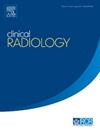放射组学特征结合血清学指标预测可切除非小细胞肺癌新辅助免疫化疗后病理完全缓解
IF 1.9
3区 医学
Q2 RADIOLOGY, NUCLEAR MEDICINE & MEDICAL IMAGING
引用次数: 0
摘要
目的探讨基于增强计算机断层扫描(CT)的δ放射组学特征(Delta-RFs)及δ - rfs联合血流变学动态变化对非小细胞肺癌(NSCLC)新辅助免疫化疗后病理完全缓解(PCR)的预测价值。材料与方法回顾性入选2021年1月至2023年8月,术前接受新辅助免疫化疗的IB-IIIB期NSCLC患者165例(训练组,n=115例,验证组,n=50例)。在预处理和术前增强CT图像上提取感兴趣的肿瘤区域的放射学特征。delta - rf被定义为新辅助免疫化疗前和术前阶段放射组学特征的相对净变化。使用最小绝对收缩和选择算子来确保最佳特征选择,以计算预测PCR的放射组学评分(Rad-score)。采用单因素和多因素logistic回归分析筛选与PCR相关的因素,构建预测模型。结果40%的患者在新辅助免疫化疗后出现PCR(66/165)。选择9个delta - rf作为PCR预测因子。Logistic回归分析显示,Rad-score (OR = 8.542, 95% CI: 3.367 ~ 21.673, P<0.001)和ΔLMR (OR = 2.637, 95% CI: 1.094 ~ 6.359, P=0.031)是与PCR相关的独立因素。在预测PCR方面,Delta-RF模型和组合模型在训练中均获得了令人满意的曲线下面积(曲线下面积[AUC]: 0.74, 0.788),验证为队列验证(AUC: 0.718, 0.737)。校正曲线显示,结合血液学动态变化模型的Delta-RF预测值与实测值吻合较好。决策曲线分析表明该模型具有较高的临床实用性。结论基于增强CT的Delta-RF模型与联合模型能有效预测非小细胞肺癌新辅助免疫化疗后的PCR,且联合模型对新辅助免疫化疗后PCR的预测效果优于单独的Delta-RF模型。本文章由计算机程序翻译,如有差异,请以英文原文为准。
Delta-radiomics features combined with haematological index predict pathological complete response after neoadjuvant immunochemotherapy in resectable non-small cell lung cancer
Aim
This study aimed at assessing the value of enhanced computed tomography (CT)-based delta-radiomics features (Delta-RFs) and Delta-RFs combined with haematological dynamic changes in predicting pathological complete response (PCR) after neoadjuvant immunochemotherapy in non-small cell lung cancer (NSCLC).
Materials and Methods
From January 2021 to August 2023, in total, 165 patients with stage IB–IIIB NSCLC (training, n=115, validation, n=50) who received neoadjuvant immunochemotherapy before surgery, were retrospectively enrolled. Radiomic features were extracted from tumour region of interest on pretreatment and pre-operation enhanced CT images. Delta-RFs are defined as the relative net change in radiomics features between pre-neoadjuvant immunochemotherapy and pre-operation stage. The least absolute shrinkage and selection operator was used to ensure optimal feature selection to calculate the radiomics score (Rad-score) for predicting PCR. Univariate and multivariate logistic regression analyses were performed to screen the factors related to PCR and predictive models were then constructed.
Results
Forty percent patients showed PCR (66/165) after neoadjuvant immunochemotherapy. Nine Delta-RFs were selected as the most predictive factors for PCR. Logistic regression analysis showed that the Rad-score (OR = 8.542, 95% CI: 3.367–21.673, P<0.001) and ΔLMR (OR = 2.637, 95% CI: 1.094–6.359, P=0.031) were independent factors associated with PCR. With respect to predicting PCR, the Delta-RF model and the combined model both achieved satisfactory areas under the curve in the training (area under the curve [AUC]: 0.74, 0.788) and the validation was found to be cohort (AUC: 0.718, 0.737). The calibration curve showed that the predicted value of Delta-RF combined with haematological dynamic change model was in good agreement with the observed value. Decision curve analysis represented that the model exhibits high clinical practicability.
Conclusions
The Delta-RF model based on enhanced CT and the combined model can aid in efficient prediction of PCR after neoadjuvant immunochemotherapy in NSCLC, and the combined model can predict PCR performance better than Delta-RF model alone after neoadjuvant immunochemotherapy.
求助全文
通过发布文献求助,成功后即可免费获取论文全文。
去求助
来源期刊

Clinical radiology
医学-核医学
CiteScore
4.70
自引率
3.80%
发文量
528
审稿时长
76 days
期刊介绍:
Clinical Radiology is published by Elsevier on behalf of The Royal College of Radiologists. Clinical Radiology is an International Journal bringing you original research, editorials and review articles on all aspects of diagnostic imaging, including:
• Computed tomography
• Magnetic resonance imaging
• Ultrasonography
• Digital radiology
• Interventional radiology
• Radiography
• Nuclear medicine
Papers on radiological protection, quality assurance, audit in radiology and matters relating to radiological training and education are also included. In addition, each issue contains correspondence, book reviews and notices of forthcoming events.
 求助内容:
求助内容: 应助结果提醒方式:
应助结果提醒方式:


